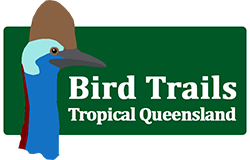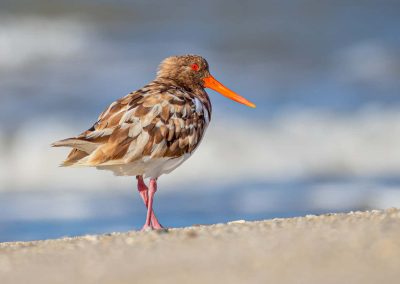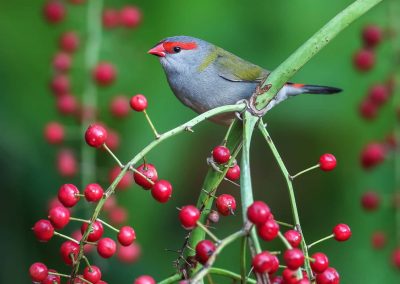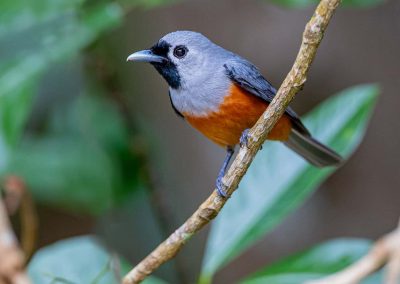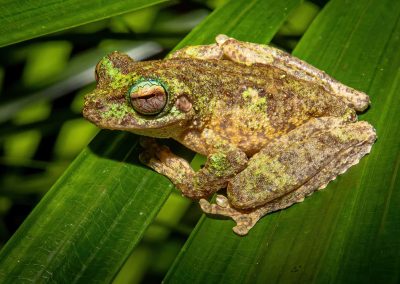North Queensland Bird Quiz
How well do you know your birds of North Queensland? All questions relate to birds that have at least some of their range in the Wet Tropics or further north on Cape York Peninsula.
Click/tap on the questions to reveal the answers.
1. Which Wet Tropics bird builds the largest bower of all Australian Bowerbirds?
Golden Bowerbird. They also have the distinction of being the smallest of all Australian bowerbirds.
2. Match each of these colloquial bird names (Axe Bird, Auctioneer-bird, Jesus-bird) with the correct bird (Comb-crested Jacana, Large-tailed Nightjar, Chowchilla).
Axe bird = Large-tailed Nightjar; Auctioneer-bird = Chowchilla; Jesus-bird = Comb-crested Jacana.
The monotonous single note call of the nightjar sounds somewhat reminiscent of axe blows, whilst the loud, rolling, chattering call of the Chowchilla could be said to be reminiscent of an auctioneer. The colloquial name of the jacana is due to its ability to work on water vegetation giving it the appearance of being able to walk on water.
3. Which two birds, endemic to the Wet Tropics, regularly forage on the rainforest floor in association - the smaller bird species following the larger?
Fernwren and Chowchilla. Chowchillas often forage in small family groups of half a dozen or more, vigorously kicking leaf litter to uncover insect prey. Fernwren often follow grabbing uncovered bugs left behind.
4. Which bird, present on the Atherton Tableland in winter, is the bird emblem of Queensland?
The bird emblem of Queensland is Brolga. The other states are as follows. Western Australia, Black Swan; Northern Territory, Wedge-tailed Eagle; South Australia, Magpie; Tasmania, Yellow Wattlebird (unofficial); Victoria, Helmeted Honeyeater; New South Wales, Laughing Kookaburra; ACT, Gang-gang Cockatoo; and the bird emblem of Australia is Emu.
5. Which bird, that occurs in North Queensland, is Australia’s heaviest flying land bird?
Australian Bustard. The average weight for a male Bustard is 6.3 kgs but can weigh up to 12 kgs. The Kori Bustard of southern Africa is reputedly the world’s heaviest flying bird and can weigh up to 19 kgs.
6. Match each of these colloquial names (Stagemaker, Whirlwindbird, Native Turkey) with the correct bird (Metallic Starling, Tooth-billed Bowerbird, Australian Bustard).
Stagemaker = Tooth-billed Bowerbird, Whirlwindbird = Metallic Starling, Native Turkey = Australian Bustard.
Tooth-billed Bowerbirds are renowned for clearing an area of rainforest floor of leaves and other debris as a ‘stage’ for courting females. Metallic Starlings can sometimes be observed in wheeling flocks called murmurations which may have lead to the colloquial name. The colloquial name of Bustard probably reflects the interest in this bird as a culinary item.
7. How many Whistling-duck species occur in North Queensland?
Three. Plumed Whistling-duck, Wandering Whistling-duck and recent colonisation by Spotted Whistling-duck from New Guinea. Before 2010, they were only really present in Cape York Peninsula locations of Weipa and Lockhart River. They then appeared in the beachside suburb or Wonga, an hour north of Cairns. Over subsequent years they then appeared in Cairns and further south to Innisvail, Mission Beach, & Townsville. Initially their presence appeared to be seasonal but from about 2016 they started to become residents with breeding observed initially on the Daintree River.
8. Which Wet Tropic endemic bird has a descending whistle call reminiscent of a falling bomb?
Lesser Sooty Owl. Pizzey & Knight, The Field Guide to the Birds of Australia, describes the voice as ‘falling bomb’ whistle, higher pitched and softer than Sooty Owl; also trills, chirrups and screams. It is certainly a fantastic call to hear and often the first indication a Lesser Sooty Owl is in the area.
9. Which bird, that occurs on Cape York Peninsula, is one of the few birds in the world known to use tools?
Palm Cockatoo are renowned for using a stick or seed pod to drum against a branch or hollow as either a territorial display or possibly to assess the size of a potential nesting hollow.
10. Match each of these birds (Eclectus Parrot, Emu, Southern Cassowary, Glossy Ibis, Masked Lapwing) with the colour of its eggs (Bright Green, Deep Blue-green, White, Dark Green, Blotched Olive-brown).
Southern Cassowary = Bright Green, Glossy Ibis = Deep Blue-green, Eclectus Parrot = White, Emu = Dark Green, Masked Lapwing = Blotched Olive-brown.
In general, those birds that lay eggs in a hollow (Eclectus Parrot), or in an excavation, will have white or pale eggs to be visible in the dark. Those birds that lay eggs on the ground (Masked Lapwing) are more likely to have a coloured egg sometimes with extensive markings to aid camouflage.
11. Which birds are depicted on current Australian bank notes?
$5 Eastern Spinebill, $10 Sulphur-crested Cockatoo, $20 Laughing Kookaburra, $50, Black Swan, $100 Masked Owl.
12. Which Cape York endemic bird nests in termite mounds and has a symbiotic relationship with a moth?
Golden-shouldered Parrots are renowned for excavating a nesting chamber within terrestrial termite mounds. A moth species (Trisyntopa scatophaga) commonly enters the nest hole to deposit eggs. Later, moth larvae consume faeces of the nesting parrots helping to keep the nest chamber clean, potentially leading to healthier chicks.
13. Which bird has a scientific name that translates to ‘two-eyed round-eyed parrot’, or maybe ‘two-eyed one-eyed parrot?
Double-eyed Fig-parrot. Scientific name is Cyclopsitta diophthalma. Psitta relates to parrot whilst cyclo refers to round or possibly one-eyed like a Cyclops. Di refers to two whilst ophthalmos refers to eye.
14. What is the rarest bird species in North Queensland?
Probably Buff-breasted Button-quail. There are now concerns about how many of this species survive. Other species of concern include Golden-shouldered Parrot whose populations are diminishing. The entire popluation is now possibly only 1000 birds. Golden Bowerbird population is possibly less than 2000. Southern Cassowary are said to have a stable population of about 3500.
15. Match each of these birds (Radjah Shelduck, Magpie Goose, Buff-breasted Paradise-kingfisher, Laughing Kookaburra, Rainbow Bee-eater) with its nesting location (On Ground, In Ground, Arboreal Termite Mound, Terrestrial Termite Mound, Tree Hollow).
Radjah Shelduck = Tree Hollow, Magpie Goose = On Ground, Buff-breasted Paradise-kingfisher = Terrestrial Termite Mound, Laughing Kookaburra = Arboreal Termite Mound, Rainbow Bee-eater = In Ground.
16. Which iconic parrot has a scientific name that translates to ‘very black snout-bearer’?
Palm Cockatoo. Scientific name is Probosciger aterrimus. Proboscis relates to a snout or trunk whilst ger refers to carry or bear. Ater refers to dull black whilst rimus is a superlative.
17. What is the commonest migrant species to North Queensland?
Probably Pied Imperial-pigeon. Around 1900 they were less common but following protection they are now common again. They arrive to Australia in early spring to spend the summer nesting before migration to New Guinea about April for the winter. Over the last couple of decades, numbers have drammatically increased, so much so that currently each summer about 30 thousand nest on Woody Island beside Low Isles off Port Douglas.
18. In regard to breeding, what do the following birds have in common? Southern Cassowary, Eclectus Parrot and Comb-crested Jacana.
All are polyandrous species with females that mate with multiple males. The breeding system employed by the Eclectus Parrot is possibly an adaption to a limited number of suitable nesting chambers in its habitat in Far North Queensland. The female stays in or near a nest hollow to guard from other birds, including Sulphur-crested Cockatoo, that may wish to use the hollow. She is attended to by 3 or 4 males, that may bring her food, may have breeding rights, and may act like a private army to protect the hollow. The cassowary and jacana are further alike it that it is the male of these species that incubates the eggs and subsequently cares for offspring.
19. Match each of these colloquial names (Golden Gardener, Croc Bird, Lousy Jack) with the correct bird (Great-billed Heron, Golden Bowerbird, Apostlebird).
Golden Gardener = Golden Bowerbird, Lousy Jack = Apostlebird, Croc Bird= Great-billed Heron.
Golden Bowerbirds are renowned for building a large double maypole bower and adorn this with treasures that sometimes includes flowers hence the colloquial name. Apostlebirds are sometimes referred to as Lousy Jacks because allegedly they “warn prey of a hunter’s progress” (Australian Bird Names, Fraser & Gray). The Great-billed Heron has a loud roaring call which is often mistaken as crocodiles fighting. Another potential reason for the colloquial name is that small crocs will sometimes be on the menu of herons.
20. Which uncommon bird is regarded as being a ‘keystone species’ in the Wet Tropics?
Southern Cassowary. A keystone species is an animal or organism whose presence and role in an ecosystem is paramount to the point that they have a disproportionate effect on other organisms within the system. Cassowary have a critical role in maintaining the diversity of the rainforest through eating whole rainforest fruits and subsequently voiding semi-digested seeds that have a higher rate of germination than seeds that have fallen direct to the ground.
